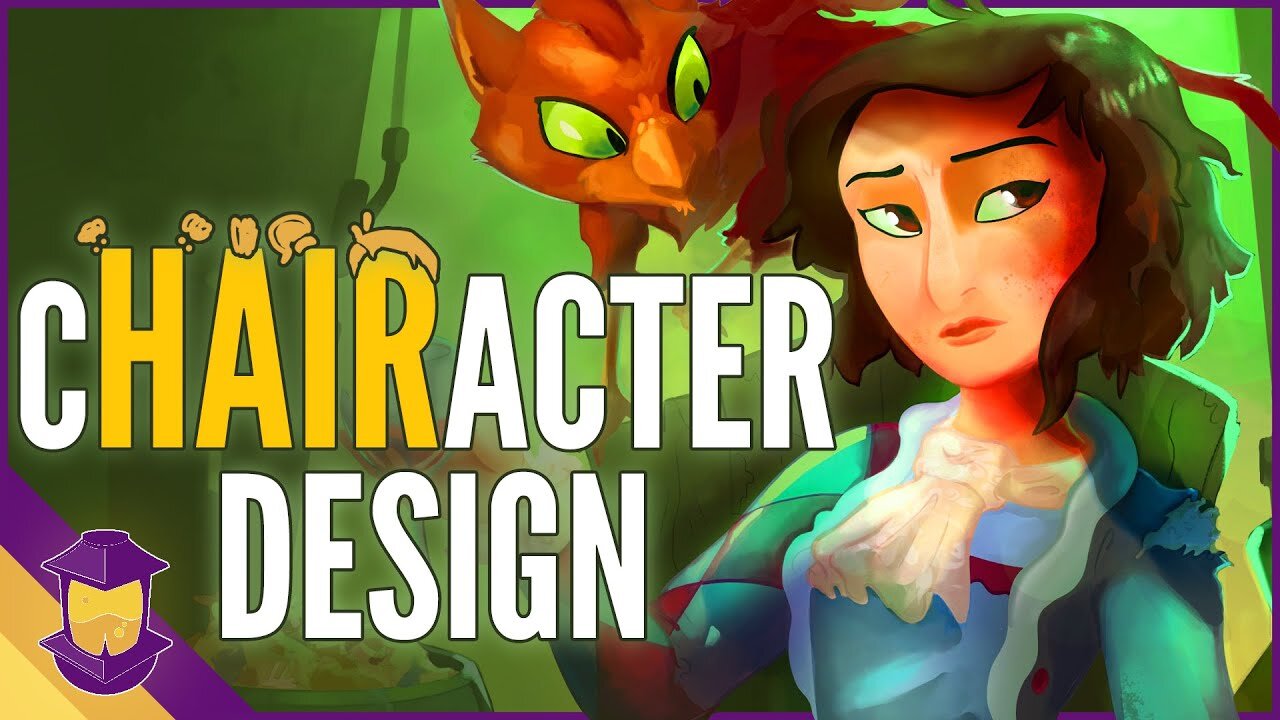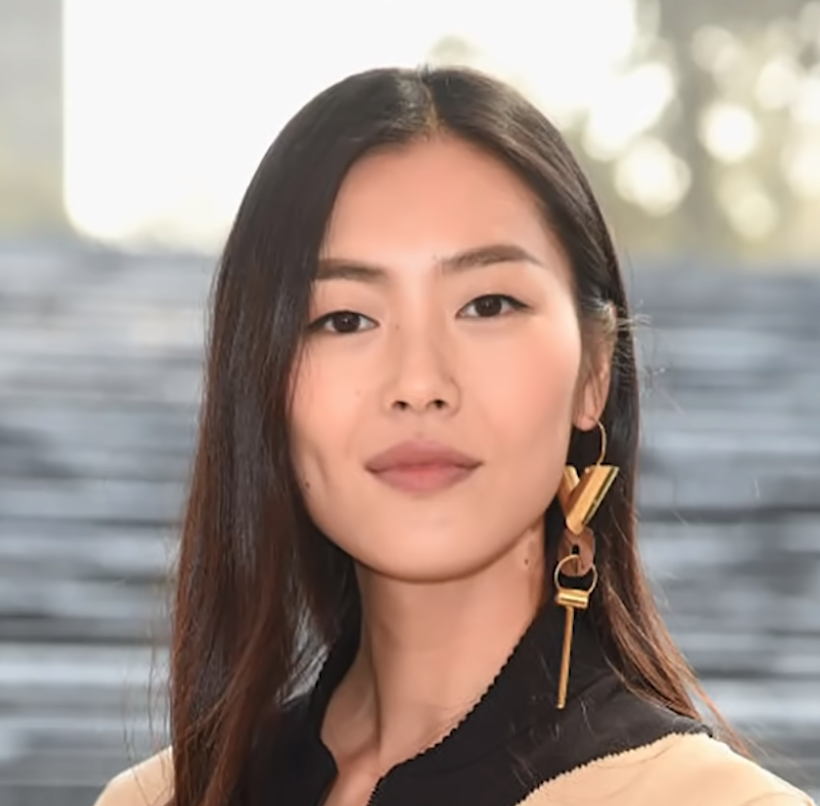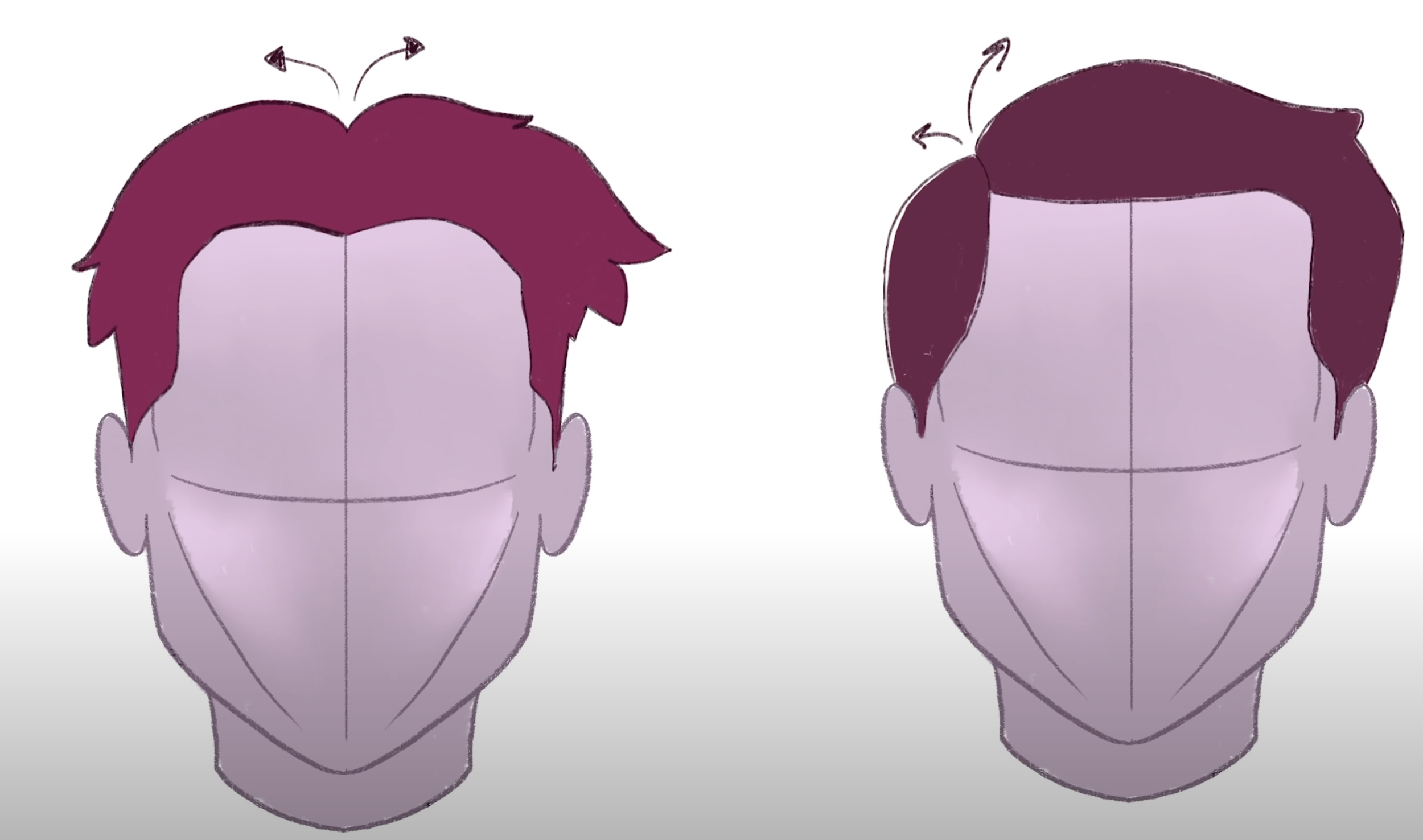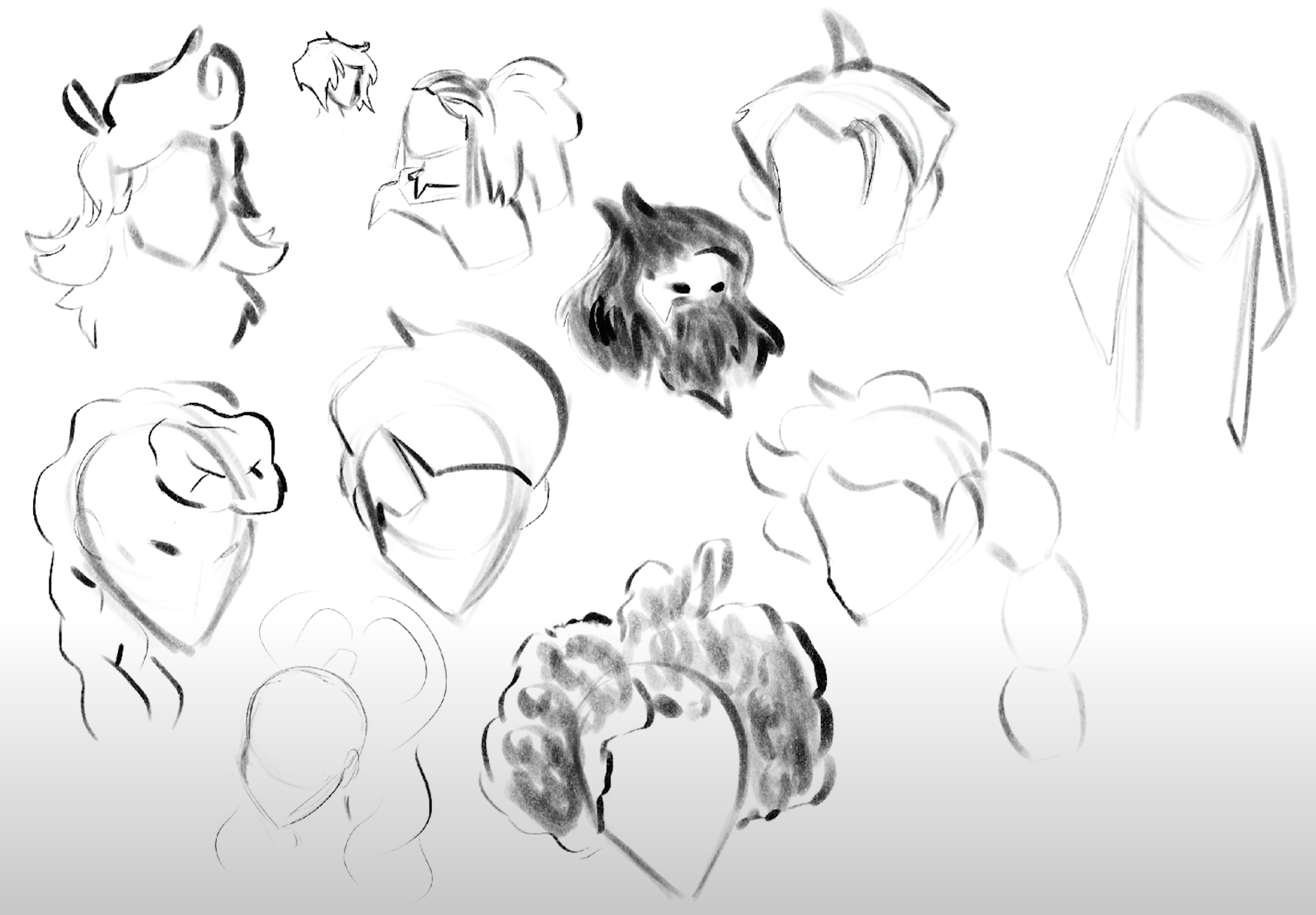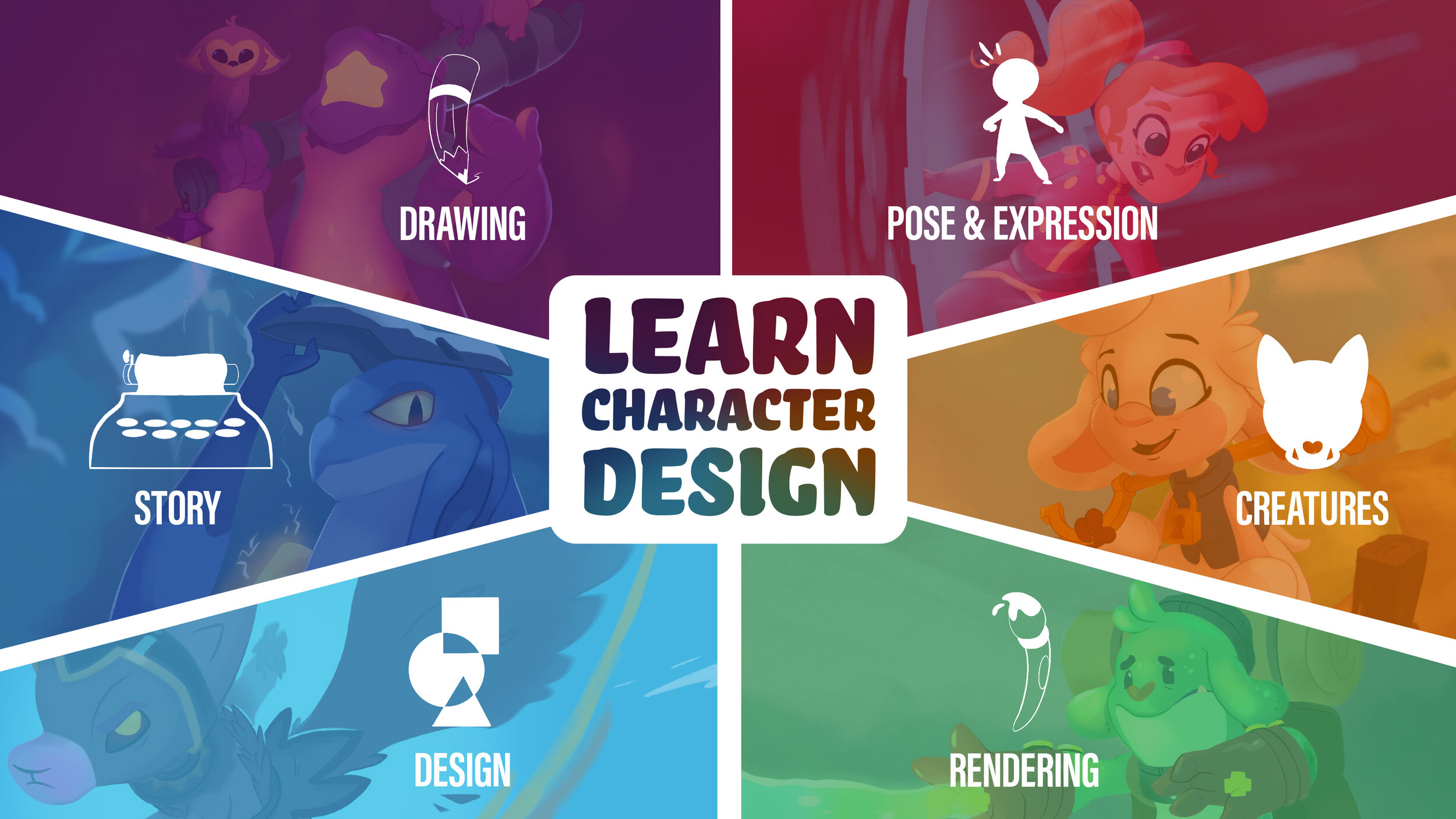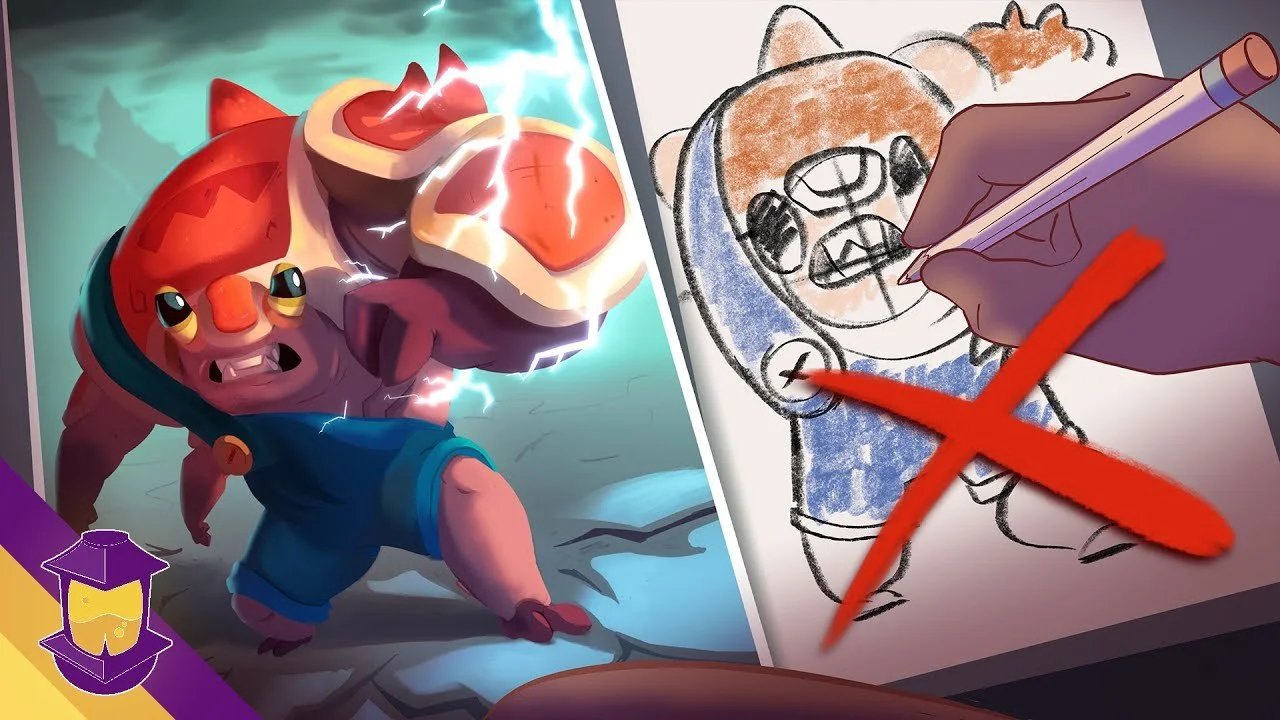How do you design AMAZING hair for your character that captures their identity and more?
Hair is a non-structural feature of human and humanoid characters, it’s a source of storytelling and self expression for characters, and it’s also- a little bit of a process to learn how to draw well.
Today we’re talking all about the practical help you need to be able to draw hair and design interesting hairstyles of your own.
Watch this video now!
Think Shape, Not Lines
The biggest element of hair to understand is shape. Not just using a spray or gel, but to think of the shape of hair first.
This might be counter to what we’re used to. After all, hair (individually) is usually long strands. So, the easiest way to represent that, of course, is with a straight or curly line—therefore we use lines to draw hair!
…Right?
Well, for multiple reasons, it’s actually much easier to think of both the overall shape and the individual segments of hair as shapes instead of individual lines.
Part of the reason for this is, we always do this when using abstraction in design. For instance, you could choose to draw every individual leaf of a tree, or you could draw the overall silhouette and draw a few individual leaves for texture. We grasp that this is a tree.
Hair can be defined with overall shapes, smaller shapes, and then texture. If we want to go further, we can add detail to bring a more realistic render to the hair.
But with shapes, hair becomes easy to recreate from different angles, re-draw, and easy to move or animate.
We’ll go further on this, but remember this workflow of broad-to-specific, not individual strands.
(Hey! Need help getting the basics down with drawing, first? Improve your drawing skills and advance your techniques with help from Module 1: Drawing from the Learn Character Design course.)
Consider the Diversity and Complexity of Hair Itself
It’s important to remember there are many different kinds of hair that exist in our world. Hair ranges from thin to thick, and from straight to wavy, to curly to coiled.
This chart is helpful, but it’s not really standardized. Because these embody genetic traits, there are plenty of opportunities for a recessive gene to come up or to have a blend of hair types. Just because something may be more rare doesn’t mean it doesn’t exist— just like eye color. Just because you are of a certain background, doesn’t mean you are guaranteed to have a certain kind of hair.
It’s also important to think of how oily hair is, which leads to tensile strength, gloss, luster, and things like that depending on how much there is, or, how grey or white the hair is.
This is a great place to educate ourselves, because outside of wigs and ultra-stylized anime hair that defies all sorts of physics, it’s helpful to think about how your character’s hair would realistically act.
In the real world, Asian hair for instance, in complete generalities, is relatively straight, thick, and tough, because it has a larger diameter than the majority of other hair.
European hair might be a light tone like blonde brown or red, relatively thin, and straight or wavy.
Black hair coils at a higher frequency than most other hair.
All of these qualities affect how a character might wear their hair, how they might style their hair, and in a lot of cases the cultural significance and role hair plays in people’s lives.
Think of the pride that the Polynesian peoples have for hair showcased in Moana, and the ease with which it’s taken down or tied up.
I’d say especially when designing hairstyles for black characters and especially women, get an understanding for just how much work goes in to styling and maintenance.
I wish I could find a thread from a few years ago that was incredibly informative regarding the time and maintenance needed for most styles alone which might mean that their lifestyle makes a certain hairstyle unrealistic. And this can go for any kind of character.
Even something like a nicely kept Afro or braids might be unrealistic in a post-apocalyptic setting for instance.
Since much of this maintenance is done much easier with another person or groups of people, it contributes to communal value and importance centered around hair care.
It’s research well spent to give some authenticity to your characters. Sometimes people just use the same hair for everyone, and it’s nowhere near as powerful. And, sometimes even “representation” has the opposite effect and makes people the character is supposed to represent feel quite the opposite.
So bounce it off of friends that have the same background. Ask, does this track? Does this honestly feel right, and how can I improve it?
Create Natural Hair Flow Through Shapes
When trying to think up those broad overall shapes, it’s helpful to think about the flow of hair. This is a place where we can create appealing shapes, and aide the gesture of our character in some cases.
On a bald head, you have a front back and back back (that’s the technical term) and each side.
You can part hair in the middle, or on one of the sides, and instantly create two separate shapes. You can pull those shapes backward or forward. Depending on the length, you can create much larger or even separate shapes off of the head.
Keep in mind that, again depending on the length and type of hair, you will frequently find ‘S’ curves— shapes that are balancing out the weight going back and forth, even in straight hair that’s long enough sometimes.
Module 3: Design in the Learn Character Design course actually breakdowns the concepts of design, and how to practically create characters using shape principles, if you want more help on this subject!
One place a lot of people seem to have trouble is the place where the hairline meets the forehead, or anywhere on the border of the head.
Here is where it helps to create both a line on the head itself, as well as a shape that’s extending off of the head. The shape that this makes can be a straight line, a wavy one, a widow’s peak which comes to a point, or a receding male-pattern baldness.
A straight to wavy line.
A widow’s peak which comes to a point.
Receding, male-pattern baldness.
Bangs or another portion of the hair can hang down, and usually this little wavy shape meets the ears, either clean cut, or with sideburns from the area in front of the ear.
Everything in between is our chia pet to manicure. Remember to treat the places where hair intersects with the head as a separate shape. This is something that has its own volume, we can get a really flat read or break our dimensionality if we aren’t careful.
Once we get our hair fundamentals down and practice the basic way that simple hairstyles in everyday life look, we can start to get more stylized and even add some subtle hints about our character’s design and silhouette to their hair.
Maybe braids or dreadlocks or clips or ties add dimension and create commas of sorts, a break in one shape and the start of another. With more intricate patterns, remember our abstraction— we don’t need to draw every little detail of a braid for instance, just use overall shape and indicate.
And while we’re making a lot of styles on this sort of neutral mannequin head for the purpose of instruction, don’t be afraid to really vary the head shape and size, and allow the shape of the hair to be an extension of those shapes.
If your character will be acting or moving in a comic or animation, see if there’s room for the hair to move around, and if a change in design could make for more interesting motion or follow through of motion. Feel free to abstract or stylize ever so slightly.
A character like Mrs. Incredible seems to have a fairly regular set of hair, but there’s sort of an iconographic flat shape her hair makes in silhouette which swoops up asymmetrically.
Her design actually started with a paper cutout that was fleshed out into 3 dimensions!
Starting with a simple shape that you slowly flesh out into something that believably came from someone’s head, (AKA reverse engineering a cool shape) can be a great way to get a cool concept down.
When you have purpose in character design, aiming to fit their personality and the like, that goes a whole lot farther!
And if you are looking to make hair look a bit more detailed, once we have our big shapes and little shapes, think about the way that light is hitting this hair. Often times a bit of a halo or rim light occurs right on the sides of the head.
This is also where the hair is sometimes more tightly packed together. Instead of making those individual lines, think about cutting negative space shapes into our smaller detail shapes to show the texture and individual strands of the hair.
We’ve touched on the element of self-expression, but hair can say a lot about our characters. Unkempt to show a chaotic and scatterbrained energy, tight or slicked back for someone controlling or even domineering.
This video is obviously about the hairstyles we put on human characters but, hair and fur is also part of animal creatures and we can use a lot of the same principles.
I’ve always had a little bit of a personal pet peeve with animal characters that look like they’re wearing a wig.
I can’t speak for everyone, but I just think it makes more sense when the hair seems like it originated from the creature it’s on.
Unless it’s supposed to be a wig like this Rabbid Peach —not that this is, like, the peak of character design.
This especially gets to me when all the male characters have seemingly realistic hair but then the female characters have like a… blonde human wig… for some reason…?
Character Redesign: Goodwyn
Here’s a bit of progress I’ve made in iterating on a character, with a few years gap in between. Goodwyn is a street urchin that I made a few years ago, and while there’s some good elements to the design the hair stands out as a real weak point.
From a rendering standpoint, this hair blowing in the wind looks pretty flat, and taking into account certain factors about the character- despite trying to be very elite and aristocratic, she’s still living on the street.
Her hair is going to be messy from encountering grime and never being washed, it’s going to be greasy from never being washed. If we’re taking into account her Asian background, t’s going to be a slightly thicker strand and not as wispy. The most practical thing, although maybe not the most austere from her perspective, would be for it to be chopped messily and uneven, like she took a dull blade to it herself and sawed if off.
In the more recent version of her here and the trading card illustration I just finished for this month’s Biko’s Backpack, it takes all those things into account and delivers a much more interesting read on the character, and plays in to some of the facial expressions she’s putting off too.
I hope these things help you to create hair styles of your own, and inspire you to really put in the practice and study of hair to improve the way you make it. Like anything, that study of what’s real will help inform the way you stylize and concept.
Oh hey tell me in the comments, who has your favorite hairstyles, fictional or otherwise? And who do you think has the most ICONIC hairstyle? I would love to hear from YOU!
Do you Want to Master your Digital Art and Character Design Skills?
Take the online course that has helped countless students master basic and advanced character design techniques.
Available Now!
Grab this month’s Biko’s Backpack over at Patreon!
Welcome to the Forge!
If you’re new here, get to know our mission here at Character Design Forge and start designing your best characters yet.

